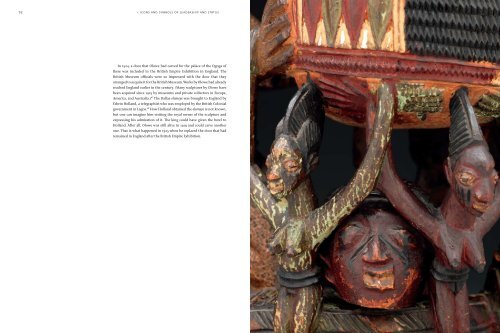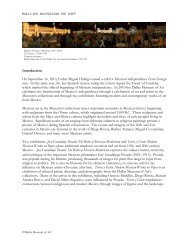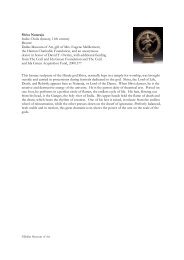the arts of africa - Dallas Museum of Art
the arts of africa - Dallas Museum of Art
the arts of africa - Dallas Museum of Art
Create successful ePaper yourself
Turn your PDF publications into a flip-book with our unique Google optimized e-Paper software.
92 1 : icons and symbols <strong>of</strong> leadership and status<br />
In 1924, a door that Olowe had carved for <strong>the</strong> palace <strong>of</strong> <strong>the</strong> Ogoga <strong>of</strong><br />
Ikere was included in <strong>the</strong> British Empire Exhibition in England. The<br />
British <strong>Museum</strong> <strong>of</strong>ficials were so impressed with <strong>the</strong> door that <strong>the</strong>y<br />
arranged to acquire it for <strong>the</strong> British <strong>Museum</strong>. Works by Olowe had already<br />
reached England earlier in <strong>the</strong> century. (Many sculptures by Olowe have<br />
been acquired since 1925 by museums and private collectors in Europe,<br />
America, and Australia.)47 The <strong>Dallas</strong> olumeye was brought to England by<br />
Edwin Holland, a telegraphist who was employed by <strong>the</strong> British Colonial<br />
government in Lagos.48 How Holland obtained <strong>the</strong> olumeye is not known,<br />
but one can imagine him visiting <strong>the</strong> royal owner <strong>of</strong> <strong>the</strong> sculpture and<br />
expressing his admiration <strong>of</strong> it. The king could have given <strong>the</strong> bowl to<br />
Holland. After all, Olowe was still alive in 1919 and could carve ano<strong>the</strong>r<br />
one. That is what happened in 1925 when he replaced <strong>the</strong> door that had<br />
remained in England after <strong>the</strong> British Empire Exhibition.




